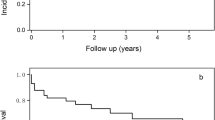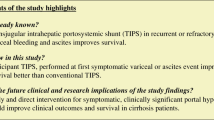Abstract
Background
Transjugular-intrahepatic portosystemic-shunt (TIPS) and SX-Ella stent Danis (DE stent) are available rescue therapies for refractory variceal bleeding in cirrhosis. Any delay in appropriate therapy is associated with high mortality. Determining the best timing for rescue TIPS is crucial and largely unknown.
Methods
Cirrhotic patients with refractory variceal bleed (n = 121) who underwent rescue TIPS within 24-h (n = 66) were included. Their early rebleed (upto 42 days) rate, 6-week and 1-year survival were compared with matched patients who underwent rescue DE stent (n = 55). Outcomes based on timing of TIPS (within 8-h/8-24 h) were also analyzed.
Results
At baseline, patients who received rescue DE stent were sicker with higher MELD score (27.6 ± 8.3 vs. 22.3 ± 7.9; p = 0.001), active bleeding at endoscopy (54.5% vs. 34.8%; p = 0.03) compared to TIPS-group. After propensity score matching, adjusting for MELD-Na score and non-bleed complications, DE patients (n = 34) had higher mortality at 6-week (17/34; 50%) and 1-year (29/34; 85.3%) compared to TIPS-group (20.6% and 38.2%, respectively; both p < 0.02), with higher rebleeding rate (10/34; 29.4% vs. 1/34; 2.9%, p = 0.003). Rescue TIPS placed within 8-h compared with 8–24 h had lower 6-week (48.6% vs. 12.9%; p = 0.003) and 1-year mortality (62.9% vs. 16.1%, p = 0.001) despite comparable rebleed rates (2/31; 6.5% vs. 2/35;5.7%; p = 0.90). Post-TIPS Portal pressure gradient at 6-weeks and 1-year was comparable between survivors and non-survivors. Active bleeding at endoscopy [HR = 11.8; 95% CI 2.96–47.53], presence of AKI [HR = 5.8; 95% CI 1.92–17.41], MELD-Na > 24 [HR = 1.1; 95% CI 1.0–1.17], mean arterial pressure > 64.5 mmHg [HR = 0.8; 95% CI 0.75–0.92] independently predicted 6-week mortality in rescue TIPS-group.
Conclusions
Rescue TIPS placement preferably within 8-h of refractory variceal bleed improves short- and long-term survival. It provides better outcome than DE stent for control of bleeding and prevention of rebleeding, even in patients with high MELD-Na score.



Similar content being viewed by others
Data availability
All data generated or analysed during this study are included in this published article (and its supplementary information files).
Abbreviations
- AVB:
-
Acute variceal bleeding
- DE:
-
SX-Ella stent Danis
- TIPS:
-
Transjugular intrahepatic portosystemic shunt
- AKI:
-
Acute kidney injury
- CT:
-
Computed tomography
- MAP:
-
Mean arterial pressure
- HVPG:
-
Hepatic venous pressure gradient
- SEMS:
-
Self-expandable metallic stent
- CTP:
-
Child–Turcotte–Pugh score
- MELD-Na:
-
Model for End Stage Liver disease sodium score
- HE:
-
Hepatic encephalopathy
- PRBC:
-
Packed red blood cell
- PPG:
-
Portal pressure gradient
References
de Franchis R. Expanding consensus in portal hypertension. J Hepatol. 2015;63(3):743–752
Sarin SK, Kumar A, Angus PW, Baijal SS, Baik SK, Bayraktar Y, et al. Diagnosis and management of acute variceal bleeding: Asian Pacific Association for Study of the Liver recommendations. Hepatol Int. 2011;5(2):607–624
D’Amico G, Pagliaro L, Bosch J. The treatment of portal hypertension: a meta-analytic review. Hepatology. 1995;22(1):332–354
Loffroy R. Transjugular intrahepatic portosystemic shunt for the management of acute variceal hemorrhage. WJG. 2013;19(37):6131
Garcia-Pagán JC, Di Pascoli M, Caca K, Laleman W, Bureau C, Appenrodt B, et al. Use of early-TIPS for high-risk variceal bleeding: results of a post-RCT surveillance study. J Hepatol. 2013;58(1):45–50
Lv Y, Yang Z, Liu L, Li K, He C, Wang Z, et al. Early TIPS with covered stents versus standard treatment for acute variceal bleeding in patients with advanced cirrhosis: a randomised controlled trial. Lancet Gastroenterol Hepatol. 2019;4(8):587–598
Garcia-Tsao G, Abraldes JG, Berzigotti A, Bosch J. Portal hypertensive bleeding in cirrhosis: Risk stratification, diagnosis, and management: 2016 practice guidance by the American Association for the study of liver diseases. Hepatology. 2017;65(1):310–335
Monescillo A, Martínez-Lagares F, Ruiz-del-Arbol L, Sierra A, Guevara C, Jiménez E, et al. Influence of portal hypertension and its early decompression by TIPS placement on the outcome of variceal bleeding. Hepatology. 2004;40(4):793–801
Li S, Zhang C, Lin LL, Wang Q, Zuo HX, Zhan AL, et al. Early-TIPS versus current standard therapy for acute variceal bleeding in cirrhosis patients: a systemic review with meta-analysis. Front Pharmacol. 2020;11:603
Nicoară-Farcău O, Han G, Rudler M, Angrisani D, Monescillo A, Torres F, et al. Effects of early placement of transjugular portosystemic shunts in patients with high-risk acute variceal bleeding: a meta-analysis of individual patient data. Gastroenterology. 2021;160(1):193-205.e10
Trebicka J, Gu W, Ibáñez-Samaniego L, Hernández-Gea V, Pitarch C, Garcia E, et al. Rebleeding and mortality risk are increased by ACLF but reduced by pre-emptive TIPS. J Hepatol. 2020;73(5):1082–1091
Trebicka J. Emergency TIPS in a Child-Pugh B patient: When does the window of opportunity open and close? J Hepatol. 2017;66(2):442–450
Sanyal AJ, Freedman AM, Luketic VA, Purdum PP, Shiffman ML, Tisnado J, et al. Transjugular intrahepatic portosystemic shunts for patients with active variceal hemorrhage unresponsive to sclerotherapy. Gastroenterology. 1996;111(1):138–146
Maimone S, Saffioti F, Filomia R, Alibrandi A, Isgrò G, Calvaruso V, et al. Predictors of re-bleeding and mortality among patients with refractory variceal bleeding undergoing salvage transjugular intrahepatic portosystemic shunt (TIPS). Dig Dis Sci. 2019;64(5):1335–1345
Azoulay D, Castaing D, Ichai P, Saliba F, Bismuth H. Intrahepatic portosystemic shunt as a salvage treatment of uncontrolled hemorrhage caused by rupture of esophageal varices in patients with liver cirrhosis. Presse Med. 1996;25(18):842–846
Maiwall R, Jamwal KD, Bhardwaj A, Bhadoria AS, Maras JS, Kumar G, et al. SX-Ella stent danis effectively controls refractory variceal bleed in patients with acute-on-chronic liver failure. Dig Dis Sci. 2018;63(2):493–501
Makris K, Spanou L. Acute kidney injury: definition, pathophysiology and clinical phenotypes. Clin Biochem Rev. 2016;37(2):85–98
Gaba RC, Lakhoo J. What constitutes liver failure after transjugular intrahepatic portosystemic shunt creation? A proposed definition and grading system. Ann Hepatol. 2016;15(2):230–235
Modha K, Kapoor B, Lopez R, Sands MJ, Carey W. Symptomatic heart failure after transjugular intrahepatic portosystemic shunt placement: incidence, outcomes, and predictors. Cardiovasc Intervent Radiol. 2018;41(4):564–571
Rössle M, Grandt D. Early transjugular intrahepatic portosystemic shunt in patients with cirrhosis and variceal bleeding. Hepatology. 2010;52(5):1847–1850
Vangeli M, Patch D, Burroughs AK. Salvage tips for uncontrolled variceal bleeding. J Hepatol. 2002;37(5):703–704
Lopera JE. Role of emergency transjugular intrahepatic portosystemic shunts. Semin intervent Radiol. 2005;22(04):253–265
Mohan BP, Chandan S, Khan SR, Kotagiri R, Kassab LL, Olaiya B, et al. Self-expanding metal stents versus TIPS in treatment of refractory bleeding esophageal varices: a systematic review and meta-analysis. Endosc Int Open. 2020;8(3):E291-300
Emergency transjugular intrahepatic portosystemic shunt: an effective and safe treatment for uncontrolled variceal bleeding | SpringerLink [Internet]. [cited 2022 May 13]. Available from: https://link.springer.com/article/https://doi.org/10.1007/s11605-019-04146-8
Helton WS, Belshaw A, Althaus S, Park S, Coldwell D, Johansen K. Critical appraisal of the angiographic portacaval shunt (TIPS). Am J Surg. 1993;165(5):566–571
Encarnacion CE, Palmaz JC, Rivera FJ, Alvarez OA, Chintapalli KN, Lutz JD, et al. Transjugular intrahepatic portosystemic shunt placement for variceal bleeding: predictors of mortality. J Vasc Interv Radiol. 1995;6(5):687–694
Maiwall R, Kumar A, Bhadoria AS, Jindal A, Kumar G, Bhardwaj A, et al. Utility of N-acetylcysteine in ischemic hepatitis in cirrhotics with acute variceal bleed: a randomized controlled trial. Hepatol Int. 2020;14(4):577–586
Salerno F, Merli M, Cazzaniga M, Valeriano V, Rossi P, Lovaria A, et al. MELD score is better than Child-Pugh score in predicting 3-month survival of patients undergoing transjugular intrahepatic portosystemic shunt. J Hepatol. 2002;36(4):494–500
Schepke M, Roth F, Fimmers R, Brensing KA, Sudhop T, Schild HH, et al. Comparison of MELD, Child-Pugh, and Emory model for the prediction of survival in patients undergoing transjugular intrahepatic portosystemic shunting. Am J Gastroenterol. 2003;98(5):1167–1174
Ahmed R, Santhanam P, Rayyan Y. MELD-Na as a prognostic indicator of 30- and 90-day mortality in patients with end-stage liver disease after creation of transjugular intrahepatic portosystemic shunt. Eur J Gastroenterol Hepatol. 2015;27(10):1226–1227
Tzeng WS, Wu RH, Lin CY, Chen JJ, Sheu MJ, Koay LB, et al. Prediction of mortality after emergent transjugular intrahepatic portosystemic shunt placement: use of APACHE II, Child-Pugh and MELD scores in Asian patients with refractory variceal hemorrhage. Korean J Radiol. 2009;10(5):481–489
Orloff MJ, Bell RH, Hyde PV, Skivolocki WP. Long-term results of emergency portacaval shunt for bleeding esophageal varices in unselected patients with alcoholic cirrhosis. Ann Surg. 1980;192(3):325–340
Russo MW, Jacques PF, Mauro M, Odell P, Brown RS. Predictors of mortality and stenosis after transjugular intrahepatic portosystemic shunt. Liver Transpl. 2002;8(3):271–277
Funding
None.
Author information
Authors and Affiliations
Contributions
AM: conceptualization, review and original draft preparation (supporting), analysis (equal), editing of manuscript (equal); SV, AJ: investigation (lead), analysis (equal) and original draft preparation (lead); YP: project administration, original draft preparation (supporting); SKS: conceptualization (lead), review and editing of manuscript (equal).
Corresponding author
Ethics declarations
Conflict of interest
Amar Mukund, Sudhir Vasistha, Ankur Jindal, Yashwant Patidar and Shiv K. Sarin have no conflict of interest to declare.
IRB approval
Obtained (IEC/2022/93/MA17).
Patient consent statement
Need for patient consent waived by IRB.
Additional information
Publisher's Note
Springer Nature remains neutral with regard to jurisdictional claims in published maps and institutional affiliations.
Supplementary Information
Below is the link to the electronic supplementary material.
Rights and permissions
Springer Nature or its licensor (e.g. a society or other partner) holds exclusive rights to this article under a publishing agreement with the author(s) or other rightsholder(s); author self-archiving of the accepted manuscript version of this article is solely governed by the terms of such publishing agreement and applicable law.
About this article
Cite this article
Mukund, A., Vasistha, S., Jindal, A. et al. Emergent rescue transjugular intrahepatic portosystemic shunt within 8 h improves survival in patients with refractory variceal bleed. Hepatol Int 17, 954–966 (2023). https://doi.org/10.1007/s12072-022-10479-5
Received:
Accepted:
Published:
Issue Date:
DOI: https://doi.org/10.1007/s12072-022-10479-5




